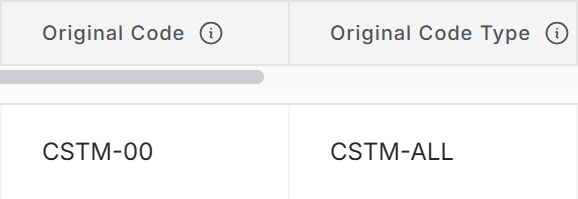Blog

MRFs
The Hidden Codes That Break Your Price Transparency Analysis
Custom (CSTM) and Local (LOCAL) codes often contain critical negotiated rate data that many vendors ignore. Learn how Serif Health normalizes these payer-specific codes to ensure your price transparency analytics are complete and accurate.
Published
10/21/2025
Being on the front-lines promoting price transparency data, the common story we hear of a client who gets burned in working with healthcare transparency data looks something like this:
- You’re excited about the Transparency in Coverage (TiC) data.
- You pay a vendor significant capital to access it.
- You run a basic query– what does an ED visit at Baylor cost with UHC?
- You try CPT 99283, RC 0450, with Baylor’s EIN, and…nothing.
- You confirm Baylor is in-network, locate additional EINs and NPIs to try, and search again. Still no result.
- You email your vendor. They’re stumped.
- You’re left frustrated–and out of time.
At Serif Health, we’ve worked hard to ensure this doesn’t happen to our partners. That’s why over 200 organizations rely on us for clean, usable price transparency data.
One of the key reasons our customers get better results?
We don’t ignore custom (CSTM) codes and local (LOCAL) codes.
The Most Overlooked Field in the Schema
Our industry-leading data-engineering, data-science, and customer success teams collaborate closely with our partners to go deep on the data and make sure we surface data-points that others may ignore or filter out of the price transparency files.
An example of this are the CSTM or LOCAL code fields that are payer-specific and rarely align with commonly recognized coding standards (e.g., CPT, DRG, HCPCS, RC, APC etc.).
According to the official CMS Github, payers are allowed to publish rates under custom coding, and these allowed code types:
| Standard Name | Reporting Value | Additional Information |
|---|---|---|
| Current Procedural Terminology | CPT | American Medical Association |
| National Drug Code | NDC | FDA NDC Background |
| Healthcare Common Procedural Coding System | HCPCS | CMS HCPCS |
| Revenue Code | RC | What is a revenue code |
| International Classification of Diseases | ICD | ICD background |
| Medicare Severity Diagnosis Related Groups | MS-DRG | CMS DRGs |
| All Patient Refined Diagnosis Related Groups | APR-DRG | AHRQ documentation |
| Ambulatory Payment Classifications | APC | APC background information |
| Local Code Processing | LOCAL | — |
| Enhanced Ambulatory Patient Grouping | EAPG | EAPG |
| Health Insurance Prospective Payment System | HIPPS | HIPPS |
| Current Dental Terminology | CDT | CDT |
| Custom Code Type: All | CSTM-ALL | This value represents all possible coding types under the contractual arrangement |
How Serif Health Solves Custom Codes
It’s fascinating what data major payers like United, Cigna, Aetna, and others (e.g., our favorite, Florida Blue) place under these codes. Luckily, Serif Health has invested in the technology and understanding of this data to automatically crosswalk this data for our customers.
At Serif, we’ve built advanced data pipelines to normalize custom codes and map them back to standard equivalents.
- Our data science team cross-walks CSTM and LOCAL codes to standard CPT, DRG, RC, and HCPCS codes.
- These mappings are validated against real contracts and standard charge files.
- We use statistical and contractual alignment techniques to ensure pricing comparability.
Here are some examples of how this data diverges from what you might expect, and how we correct for that:
1. Emergency Department visit at Baylor (UnitedHealthcare)
For example: that Baylor Emergency Department Visit reimbursement we talked about earlier?
- Problem: UnitedHealthcare reports it under Custom Code: ‘EMR3’, so it’s not discoverable via CPT 99283 unless you cross-walk codes
- Solution: Serif Health autolinks EMR3 with CPT 99283, so you can easily look up this service and get an accurate rate.


2. Colonoscopy at Rush Medical Center (Cigna)
Curious what a colonoscopy costs at Rush Medical Center in Chicago?
- Problem: Cigna reports it under Custom Code: ‘CSTM-00’, helpfully labeled with the note ‘Outpatient services not otherwise priced’
- Solution: Serif Health has created bridges between hospital data, payer data, and claims to fix this. For % of billed charge arrangements like these that cover a wide range of outpatient services, we use the hospitals’ MRFs and claims to translate those percentages to actual dollar amounts at the procedure level based on their standard charges.


- Serif Standardized Charge:

3. Behavioral Health Residential Per Diems (Aetna)
Are you in behavioral health and want to find per-diems for residential or partial hospitalization programs?
- Problem: Aetna reports some residential per-diems under Local Code: ‘RTEATDIS’
- Solution: Generate a crosswalk from unknown Local code to relevant Revenue Code / HCPCS codes in MRF files. For this Local code, this translates to a residential level of care (Revenue Code 1001-1002 or HCPCS H0018):


4. Partial Hospitalization Program at FL Blue
- Problem: FL Blue reports partial hospitalization (PHP) under Local Code: ‘SYSP8A’
- Solution: Create a link from an unknown Local code to relevant Revenue Code / CPT codes in MRF files. For SYSP8A, this translates to a PHP level of care (Revenue Code 0912 / HCPCS code S0201 for Substance Abuse or Revenue Code 0913 / HCPCS code H0035 for mental health):


What This Means for You
While saying all the important data hides under CUSTOM or LOCAL codes no one has seen before is a likely over-statement, it is no doubt true a market analysis (especially one involving outpatient facility fees for several large, marquee payers) would be incomplete and inaccurate without accounting for the CSTM dimension.
Fortunately though for anyone trying to utilize the price transparency data, we at Serif have done our best to remove the custom code headache.
If you want to search that Emergency Department visit rate with Baylor, you do not have to worry about figuring out ‘EMR3.’ You can pass in the standard CPT code - 99283 - and receive the result you expect:

It is really that easy.
Our data science and advanced analytics teams have done the painstaking work to cross-walk CUSTOM and LOCAL codes to their appropriate standard CPT, DRG, RC, HCPCS analogs so this valuable data does not go missing.
We have validated these cross-walks against real contract paper and used statistical techniques as well to ensure the standard codes we pick have values in line with the CSTM ones.
Who Benefits Most
This unlock is a game-changer for:
- Actuaries & Health Economists: Running claims re-pricing models or plan comparisons
- Contracting Teams: Benchmarking outpatient facility fees across payers
- Navigation & Tech Vendors: Quoting real costs via MRFs without dead ends
See It in Action
If you’re currently using a price transparency vendor, we’d be happy to show how our data compares. Or if you’re just curious how much is hiding in those custom fields, reach out:
📩 hello@serifhealth.com
🔗 Follow us on LinkedIn for future updates
Final Takeaway
Custom codes aren’t edge cases, they’re the core of many contracts. If your vendor isn’t accounting for them, your insights are incomplete.
We’ve done the hard work of decoding custom codes–so your analysis is complete from day one.